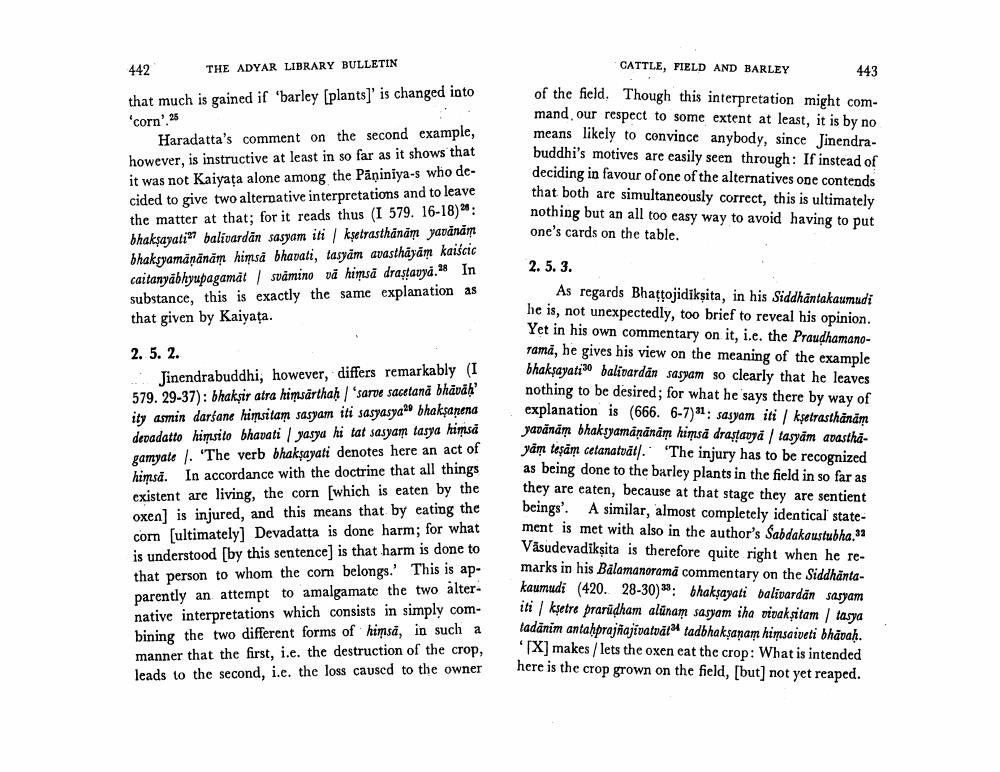Book Title: Cattle Field And Barley Note On Mahabhasya Author(s): A Wezler Publisher: A Wezler View full book textPage 7
________________ 442 THE ADYAR LIBRARY BULLETIN CATTLE, FIELD AND BARLEY 443 that much is gained if 'barley (plants)' is changed into 'corn'. 25 Haradatta's comment on the second example, however, is instructive at least in so far as it shows that it was not Kaiyața alone among the Pāṇiniya-s who decided to give two alternative interpretations and to leave the matter at that; for it reads thus (1 579. 16-18): bhakşayati” balivardan sasyam iti kşetrasthanam yavänām bhaksyamänänäm himsa bhavati, tasyam avasthayām kaiścic caitanyabhyupagamåt / svamino vä himsa drastavyd. 28 In substance, this is exactly the same explanation as that given by Kaiyata. of the field. Though this interpretation might command our respect to some extent at least, it is by no means likely to convince anybody, since Jinendrabuddhi's motives are easily seen through: If instead of deciding in favour of one of the alternatives one contends that both are simultaneously correct, this is ultimately nothing but an all too easy way to avoid having to put one's cards on the table. 2. 5. 2. Jinendrabuddhi; however, differs remarkably (I 579. 29-37): bhakşir atra himsärthah / 'sarve sacetana bhavaḥ' ity asmin darsane himsitam sasyam iti sasyasya' bhaksarena devadatto himsito bhavati pasya hi tat sasyam tasya himpisa gamyate. The verb bhakşayati denotes here an act of himsa. In accordance with the doctrine that all things existent are living, the corn (which is eaten by the oxen) is injured, and this means that by eating the corn (ultimately] Devadatta is done harm; for what is understood [by this sentence] is that harm is done to that person to whom the corn belongs.' This is apparently an attempt to amalgamate the two alternative interpretations which consists in simply combining the two different forms of himsa, in such a manner that the first, i.e. the destruction of the crop, leads to the second, i.e. the loss caused to the owner 2. 5. 3. As regards Bhattojidikșita, in his Siddhantakaumudi he is, not unexpectedly, too brief to reveal his opinion. Yet in his own commentary on it, i.e. the Praudhamanorama, he gives his view on the meaning of the example bhakşayatia balivardan sasyam so clearly that he leaves nothing to be desired; for what he says there by way of explanation is (666. 6-7)31: sasyam iti kşetrasthanam yavänām bhak syamanānām himså drastavyä | tasyam avasthayam teşām cetanatvät. 'The injury has to be recognized as being done to the barley plants in the field in so far as they are eaten, because at that stage they are sentient beings'. A similar, almost completely identical statement is met with also in the author's Sabdakoustubha. 9a Väsudevadikşita is therefore quite right when he remarks in his Bälamanorama commentary on the Siddhantakaumudi (420. 28-30). bhakşayati balivardan sosyam itiksetre prarüdham alūnam sasyam iha vivaksitam | tasya tadanim antahprajñajivatvāt tadbhakşanam himsaiveti bhavaḥ. TX] makes / lets the oxen eat the crop: What is intended here is the crop grown on the field. Ibut not vet reanedPage Navigation
1 ... 5 6 7 8 9 10 11 12 13 14 15 16 17 18 19 20 21 22 23 24
